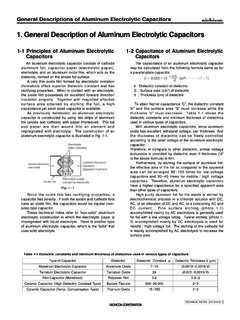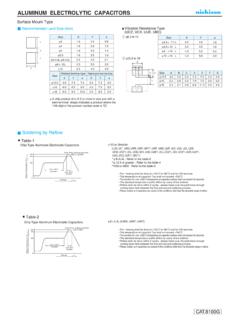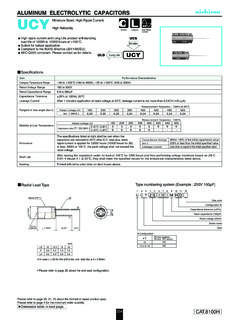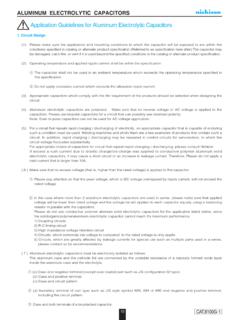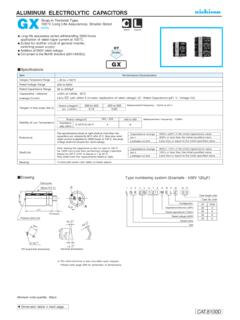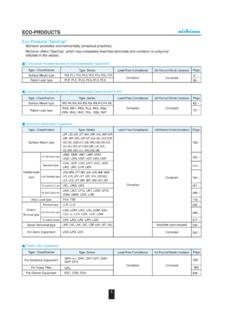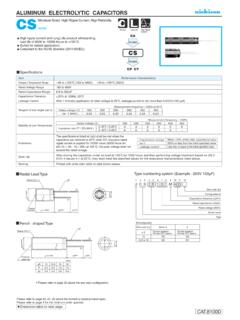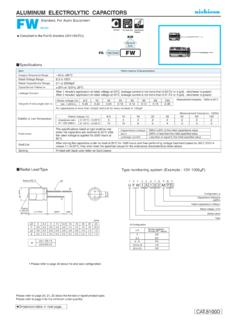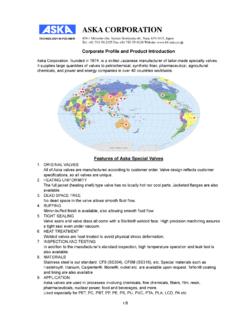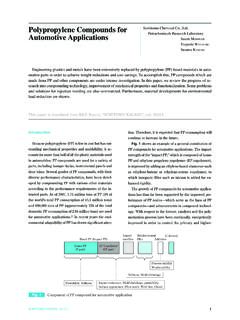Transcription of Aluminum Solid Electrolytic Capacitors with …
1 CAT. 8200B 2012 Aluminum Solid Electrolytic Capacitorswith Functional PolymerNICHICON CORPORATION / FPCAP ELECTRONICS (SUZHOU) CO., CORPORATION / FPCAP ELECTRONICS (SUZHOU) CO., Precautions on FPCAP itself1 General Precautions at Designing, for Use and Handling2 Products List6 Green Products6 System Diagram7 Products / Radial Lead TypeNS series8R7 series10R5 series12L8 series14E5 series16S8 series18F8 series20NU series22NE series24S6 series26HT series28 Products / SMD TypePS, PA series30HS, HA series32SS, SA, SB series34FS series36SL series38VA, VB series40 Ordering Information42 Packing Specifications43 Materials and Soldering46 Technical Guide50 Estimating of Lifetime54 Application Guide55 NICHICON CORPORATION / FPCAP ELECTRONICS (SUZHOU) CO., Precautions on itselfPrecautionsFunctional Polymer Aluminum Solid Electrolytic Capacitors1.
2 PolarityThe FPCAPhas polarity. Consequently, make sure polarity is never reversed when polarity is reversed, leakage current could increase or lifetime could Applied VoltageUnder no circumstances can reverse voltage be applied. It may cause a short Sudden charge and dischargeKeep sudden charge and discharge to a minimum. It may create a short circuit or cause high leakage this case, it is recommended to use a protection circuit in order to maintain high , using protection circuit to ensure reliability is recommended when the rush current value exceeds make sure to insert a protection resistor of about 1k for charge and discharge when measuring the leakage SolderingThe soldering conditions must be kept within the permissible range prescribed in the catalog the specification is not kept, there is the possibility of abnormal appearance and abnormal leakage current and reduced Installation on PC boardWhen designing the layout of your PC board using the FPCAP please take into consideration the standard mounting FPCAPcan not be able to be mounted on a PC board if there is insufficient Directions for use in circuitsSince leakage current fluctuations can occur during the soldering process the FPCAP cannot be used in the following circuits.
3 (1) High impedance voltage retention circuits(2) Coupling circuits(3) Time constant circuits(4) Circuits greatly affected by leakage current(5) Connecting two or more FPCAPin series1 NICHICON CORPORATION / FPCAP ELECTRONICS (SUZHOU) CO., Precautions at Designing, for Use and HandlingPrecautions1. Circuit design precautions(1) Check the rated performanceAfter checking the operation and installation environments, design the circuit so that it falls within the rated performance range stipulated in the catalog specification. (2) Operating temperature and ripple currenta) Set the operating temperature so that it falls within the range stipulated in the catalog ) Do not apply current that exceeds the allowable ripple current in the catalog.(3) Leakage currentEven when the soldering conditions fall within the range of the catalog specification, the leakage current increases also increases slightly during high temperature no-load, moisture-proof no-load and temperature cycling tests with no voltage cases such as these, leakage current will decrease by applying voltage in conditions below the maximum operating temperature.
4 (4) Applied voltage Considerationsa) Make sure the sum of the peak DC voltage and ripple voltage values does not exceed the rated ) Please do not apply the reverse voltage to ) When the DC voltage is low, please check whether the peak value of ripple voltage does not become a reverse voltage.(5) Reduction of failure stressThe main failure mode of the FPCAPis in the open mode primarily caused by an electrostatic capacitance drop. Random short circuit mode failures occur time it takes to reach the failure mode can be extended by using the FPCAP with reduced ambient temperature, ripple current and applied voltage.(6) Capacitor insulationa) Insulation is not ) Be sure to completely separate the case, negative electrode terminal and positive electrode terminal from adjacent components and PC board traces.
5 (7) Operating environmentDo not use the FPCAPin the following ) Places where it can come into direct contact with water or salt water and places where condensation may ) Places filled with noxious gasses such as: hydrogen sulfide, sulfurous acid, nitrous acid, chlorine, ammonia, ) Places exposed to ozone, ultraviolet rays and ) Where severe vibration or shock which exceeds the condition specified in the specification sheets.(8) Assembly Conditions ConsiderationsIn designing a circuit, the following conditions should be checked before the FPCAPis mounted on the PC ) The pitch and diameter of PCB holes to which the FPCAPis mounted, shall be designed in conformance with the dimensional tolerance stipulated in the catalog specifications.(9) PC boardAvoid locating heat-generating components around the FPCAPand on the underside of the PC board under the FPCAP.
6 (10) Parallel connectionWhen used in a parallel connection with another capacitor, carefully select the type of capacitor.(11) Othera) Electrical characteristics are affected by fluctuations in temperature and ) When mounting the FPCAPon a double-sided PC board, design the board so that extra PC board holes are not located underneath the CORPORATION / FPCAP ELECTRONICS (SUZHOU) CO., Mounting precautions(1) Things to know before mountinga) Do not reuse the FPCAP that has already been assembled in a device and the FPCAP that has been removed for measuring electrical characteristics during a periodic inspection, they cannot be ) Leakage current may increase if the part has been stored for a long period of this case, use after voltage treatment under the rated voltage.(2) Mounting-1a) Mount after checking the capacitance and the rated ) Mount after checking the ) Do not drop on the floor and do not use parts that have been ) Do not deform and then mount.
7 (3) Mounting-2a) Mount after checking the match between the lead pitch and the PC board holes ) When an automatic insertion equipment is used to clinch the lead wires, make sure it is set ) Be careful of the shock force that can be produced by the automatic insertion ) Do not apply excessive external force to the lead wires, the FPCAP itself, or the electrode terminals.(4) Soldering with a soldering irona) Set the soldering conditions (temperature, time) so that they fall within the range stipulated by the catalog ) When the lead wire terminal must be processed because the terminal spacing and the PC board holes spacing do not match, process it before soldering so that no stress is applied to the ) Do not subject the FPCAP itself to excessive stress when soldering with a soldering ) When a soldering iron is used to repair the FPCAP that has already been soldered once and needs to be removed, do it after the solder has been completely melted so that no stress is applied to the ) Do not let the tip of the soldering iron touch the ) The amount of leakage current after soldering may increase a slightly (from a few A to several hundred A)
8 Depending on the soldering condition (preheating and solder temperature and time, PC board material and thickness, etc.)The leakage current can be reduced by applying voltage.(5) Flow soldering (Radial lead type)a) Never submerge the FPCAPin molten solder. Use the PC board to protect the FPCAPand only solder the opposite side of the board that the FPCAPis mounted ) Set the soldering conditions (soldering temperature, terminal submersion time) so that they fall within the range stipulatedby the catalog specification. The amount of leakage current after soldering may increase slightly (from a few A to several hundred A) depending on the soldering conditions (preheating and solder temperature and time, PC board material and thickness, etc.). The leakage current can be reduced through self-repair by applying ) Take care that flux does not adhere to any place other than the ) When soldering, take care that other components do not fall over and touch the ) Flow soldering under extremely abnormal conditions may reduce the capacitance of products before or after soldering.
9 (6) Reflow soldering (SMD type)Do not use reflow soldering for Radial lead type (Through Hole).a) Never submerge the FPCAPin molten solder. Use the PC board to protect the FPCAPand only solder the opposite side of the board that the FPCAPis mounted ) Set the soldering conditions (soldering temperature, terminal submersion time) so that they fall within the range stipulated by the catalog specification. The amount of leakage current after soldering may increase slightly (from a few A to several hundred A) depending on the soldering conditions (preheating and solder temperature and time, PC board material and thickness, etc.). The leakage current can be reduced through self-repair by applying ) Take care that flux does not adhere to any place other than the ) When soldering, take care that other components do not fall over and touch the ) Reflow soldering under extremely abnormal conditions may reduce the capacitance of products before or after ) Do not use VPS (Vapor Phase Soldering).
10 3 NICHICON CORPORATION / FPCAP ELECTRONICS (SUZHOU) CO., (7) Handling after solderinga) Do not tilt, bend or twist the FPCAP after it has been soldered on the PC ) Do not use the FPCAPas a handle to move the PC board after it has been attached to ) Do not bump the FPCAP with objects after it has been soldered to the PC board. Make sure the FPCAP does not touch other PC boards or ) Do not subject to excessive stress after it has been soldered to the PC board.(8) Washing the PC boardCheck the following items before washing the PC board with these detergents; high quality alcohol-based cleaning fluid such as Pine- ST-100S, Clean-thru 750H, 750L, 750K, or Techno Care FRW14 through 17; or detergents including substitute Freon such as AK-225 AES and ) Use immersion or ultrasonic wave to clean for a total of less than five ) The temperature of the cleaning fluid should be less than 60 ) Watch for contamination of the detergent (conductivity, pH, specific gravity, water content, etc.
